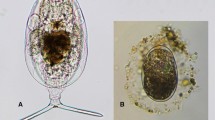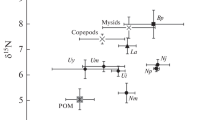Summary
In 1986 and 1987 the seasonal course of population density, life history traits and biomass composition (CHN-elemental and ash) of two coexisting Daphnia species from L. Constance (Überlinger See) were studied. The two daphnids are morphologically similar, but demonstrate different seasonal variation of behaviour (i.e. diurnal vertical migration). With the exception of nitrogen content, the mean biomass composition of adults and that of eggs were significantly different: the dry biomass of eggs (adults) contained on average 55.6 (46.1) % C, 7.9 (6.5) % H, 9.7 (9.7) % N, and 10.0 (23.8) % ash. These values were similar to those of other daphnids; it may be concluded that the average daphnid composition is not species specific, but is determined mainly by the position in the life cycle and by the nutritional state of the animal. A distinct seasonal variation in the elemental composition of the biomass of adult daphnids was observed. It related significantly to the concentration of food, as indicated by the epilimnetic chlorophyll-a concentrations and by Secchi depth. From the amplitude of seasonal variation of elemental composition and from the shape of relationships between the elemental composition of daphnids and their food, it can be concluded that in summer the non-migrating D. galeata lives under stronger food limitation than the migrating H. hyalina. In spring, there were no differences in the biomass composition of either species. In summer, the adult fcmales of D. galeata contained significantly less carbon, and hydrogen than those of D. hyalina. In most parameters of biomass (i.e. biomass composition of adults) and of life history (i.e. clutch size, mean adult weight), D. galeata displayed higher coefficients of variation. A tendency in D. galeata to have peaks of population development carlier in the season and in D. hyalina to have them towards autumn was observed. These contrasting responses of the populations development, the seasonal variability of the biomass composition seem to support the view of Geller (1986) who called D. galeata and D. hyalina “exploitative” and “conservative” strategists respectively.
Similar content being viewed by others
References
Anger K, Laasch N, Püschel C, Schorn F (1983) Changes in biomass and chemical composition of spider crab (Hyas araneus) larvae reared in the laboratory. Mar Ecol Prog Ser 12:91–101
Balvay G (1987) Equivalence entre quelques paramètres estimatifs de l'abondance du zooplancton total. Schweiz Z Hydrol 49:75–84
Bamstedt U (1986) Chemical composition and energy content. In: Corner EDS, O'Hara SCM (eds) The biological chemistry of marine copepods. Clarendon Press, Oxford, pp 1–58
Baudoin FM, Ravera O (1972) Weight, size, and chemical composition of some freshwater zooplankters: Daphnia hyalina (LEY-DIG). Limnol Oceanogr 17:645–649
Berberovic R, Bikar K, Geller W (1990) Seasonal variability of the embryonic development time of three planktonic crustaceans: dependence on temperature, adult size, and egg weight. Hydrobiologia (in press)
Bertoni R (1983) Automatic determination of carbon and nitrogen in suspended mater of natural water with Carlo Erba 1106 CHN elemental analyzer. Mem Ist Ital Idrobiol 36:297–301
Bikar K (1986) Dauer der Eierentwicklung von Planktoncrustaceen des Überlinger Sees (Bodensee) in Abhängigkeit von der saisonalen Variation der Umgebungstemperatur, der Adultgröße und des Eigewichts. Dipl Thes, Univ. Freiburg, p 119
Bottrell HH, Robins DB (1984) Seasonal variations in length, dry weight, carbon, and nitrogen of Calanus helgolandicus from the Celtic sea. Mar Ecol Prog Ser 14:259–268
Childress JJ, Nygaard M (1974) Chemical composition and buoyancy of midwater Crustaceans as function of depth of occurrence off Southern California. Mar Biol 27:225–238
Corkett CJ, McLaren IA (1978) The biology of Pseudocalanus. Adv Mar Biol 15:231
Duncan A (1985) Body carbon in daphnids as an indicator of the food concentration available in the field. Arch Hydrobiol Beih 21:81–90
Elendt B-P (1989) Effects of starvation on growth, reproduction, survival and biochemical composition of Daphnia magna. Arch Hydrobiol 116:415–433
Enright JT (1977) Diurnal vertical migration: adaptive significance and timing. Part 1. Selective advantage: a metabolic model. Limnol Oceanogr 22:856–872
Geller W (1980) Stabile Zeitmuster in der Planktonsukzession des Bodensees (Überlinger See). Verh Ges Ökol 8:373–382
Geller W (1986) Diurnal vertical migration of zooplankton in a temperate great lake (L. Constance): A starvation avoidance mechanism? Arch Hydrobiol Suppl 74:1–60
Geller W (1988) The nergy budget of two sympatric Daphnia species in Lake Constance: productivity and energy residence times. Oecologia 78:242–250
Geller W, Müller H (1985) Seasonal variability in the relationship between body weight and individual dry weight as related to food abundance and clutch size in two coexisting Daphnia species. J Plankt Res 7:1–18
Giese AC (1967) Some methods for study of the biochemical constitution of marine invertebrates. Oceanogr Mar Biol Ann Rev 5:159–186
Giguère LA, St-Pierre J-F, Bernier B, Vezina A, Rondeau J-G (1989) Can we estimate the true weight of zooplankton samples after chemical preservation? Can J Fish Aquat Sci 46:522–527
Gnaiger E, Bitterlich G (1984) Proximate biochemical composition and caloric content calculated from the elemental CHN analysis: A stoichiometric concept. Oecologia 62:289–298
Green J (1956) Growth, size, and reproduction in Daphnia (Crustacea: Cladocera). J Zool 126:173–204
Haney JF, Hall DJ (1973) Sugar coated Daphnia: A preservation technique for Cladocera. Limnol Oceanogr 18:331–333
Hawkins ALS, Salkeld PN, Bayne BL, Gnaiger E, Lowe DM (1985) Feeding and resource allocation in the mussel Mytilus edulis: evidence for time-averaged optimization. Mar Ecol Prog Ser 20:273–287
Hedges JI, Stern JH (1984) Carbon and nitrogen determination of carbonate-containing soilds. Limnol Oceanogr 29:657–663
Hedges JI, Cowie GL, Ertel JE, Barbour RJ, Hatcher PG (1985) Degradation of carbohydrates and lignins in buried woods. Geochim Cosmochim Acta 49:701–711
Hessen DO (1989) Factors determining the nutritive status and production of zooplankton in a humic lake. J Plankt Res 11:649–664
Hoenicke R, Goldman CR (1987) Resource dynamics and seasonal changes in competitive interactions among three cladoceran species. J Plankt Res 9:397–417
Hopkins CCE, Tande KS, Gronvik S (1984) Ecological investigations of the zooplankton community of Balsfjorden, Northern Norway: an analysis of growth and overwintering tactics in relation to niche and environment in Metridia longa (LUB-BOCK), Calanus finmarchicus (GUNNERTUS), Thyssanoessa inermis (KROYER), and T. raschi (SARS). J Exp Mar Biol Ecol 2:77–99
Kerambrun P (1987) Composition chimique élémentaire (C, H, N) et équivalent énergie d'Acartia clausi (Crustacea: Copepoda), espèce importante dans la bioénergétique des écosystèmes côtiers de Méditerranée nord-occidentale. Mar Biol 95:115–121
Kerfoot WC (1974) Egg-size cycle of a cladoceran. Ecology 55:1259–1270
Lampert W, Schober U (1978) Das regelmäßige Auftreten von Frühjahrsalgenmaximum und “Klarwasserstadium” im Bodensee als Folge von klimatischen Bedingungen und Wechselwirkungen zwischen Phyto-und Zooplankton. Arch Hydrobiol 82:364–386
Lemcke HW, Lampert W (1975) Veränderungen im Gewicht und der chemischen Zusammensetzung von Daphnia pulex im Hunger. Arch Hydrobiol Suppl 48:108–137
Lynch M, Weider LJ, Lampert W (1986) Measurement of the carbon balance in Daphnia. Limnol Oceanogr 31:17–33
Omori M (1969) Weight and chemical composition of some important oceanic zooplankton in the North Pacific Ocean. Mar Biol 3:4–10
Paine RT (1971) The measurement and application of the calorie to ecological problems. Ann Rev Ecol Syst 2:145–164
Peters RH (1987) Metabolism in Daphnia. In: Peters RH, de Bernardi R (eds) Daphnia. Mem Ist Ital Idrobiol 45:193–243
Pourriot R, Leborgne L (1970) Teneurs en proteines, lipides et glucides de zooplancton d'eau douce. Ann Hydrobiol 1:171–178
Rausch T (1981) Verschiebungen der biochemischen Zusammensetzung von Phytoplankton als Indikator physiologischer Zustände. Verh Ges Ökol 9:43–52
Raymont JEG, Srinivasagan RT, Raymont JKB (1971) Biochemical studies on marine zooplankton IX. The biochemical composition of Euphausia superba. J Mar Biol Ass UK 51:581–588
Salonen K, Sarvala J, Hakala I, Viljanen M-L (1976) The relation of energy and organic carbon in aquatic invertebrates. Limnol Oceanogr 21:724–730
Schindler DW, Clark AS, Gray JR (1971) Seasonal calorific values of freshwater zooplankton, as determined with a phillipson bomb calorimeter modified for small samples. J Fish Res Bd Canada 28:559–564
Schram MD, Schmitz EH (1983) Correlation of organic carbon and dry weight data as indices of fresh-water zooplankton biomass. Hydrobiologia 106:283–284
Siefken M, Armitage KB (1968) Seasonal variation in metabolism and organic nutrients in three Diaptomus (Crustacea: Copepoda). Comp Biochem Physiol 24:591–609
Simon M, Tilzer MM (1987) Bacterial response to seasonal changes in primary production and phytoplankton biomass in Lake Constance. J Plankt Res 9:535–552
Sommer U (1981) Phytoplanktonbiozönosen und-sukzessionen im Bodensee/Überlinger See. Verh Ges Ökol 9:33–42
Spoehr HA, Milner HW (1949) The chemical composition of Chlorella, effect of environmental conditions. Plant Physiol 24:120–149
Stabel HH (1985) Mechanisms controlling the sedimentation sequence of various elements in prealpine lakes. In: Stumm W (ed) Chemical processes in lakes. Wiley, New York, pp 143–167
Sterner RW (1989) Grazers and phytoplankton succession. In: Sommer U (ed) Plankton ecology: Succession in plankton communities. Science Tech Publishers/Springer Verlag, Madison, Visconsin, pp 107–170
Stich H-B, Lampert W (1981) Predator evasion as an explanation of diurnal vertical migration by zooplankton. Nature 293:396–398
Tessier AJ, Goulden CE (1982) Estimating food limitation in cladoceran populations. Limnol Oceanogr 27:707–717
Threlkeld ST (1976) Starvation and the size structure of zooplankton communities. Freshw Biol 6:489–496
Threlkeld ST (1979) Estimating cladoceran birth rates: The importance of egg mortality and the egg age distribution. Limnol Oceanogr 24:601–612
Threlkeld ST (1987) Daphnia life history strategies and resource allocation patterns. In: Peters RH, de Bernardi R (eds) Daphnia. Mem Ist Ital Idrobiol 45:353–366
Vijverberg J, Frank TH (1976) The chemical composition and energy contents of copepods and cladocerans in relation to their size. Freshw Biol 6:333–345
Vollenweider RA (1985) Elemental and biochemical composition of plankton biomass: some comments and explorations. Arch Hydrobiol 105:11–29
Wissing TE, Hasler AD (1968) Calorific values of some invertebrates in Lake Mendota, Wisconsin. J Fish Res Bd Canada 25:2515–2518
Author information
Authors and Affiliations
Additional information
This research was supported by the Deutsche Forschungsge-meinschaft within the Sonderforschungsbereich “Cycling of Matter in Lake Constance” (SFB 248), and by scholarship to R.B. from the Deutscher Akademischer Austauschdienst (DAAD)
Rights and permissions
About this article
Cite this article
Berberovic, R. Elemental composition of two coexisting Daphnia species during the seasonal course of population development in Lake Constance. Oecologia 84, 340–350 (1990). https://doi.org/10.1007/BF00329757
Received:
Accepted:
Issue Date:
DOI: https://doi.org/10.1007/BF00329757




